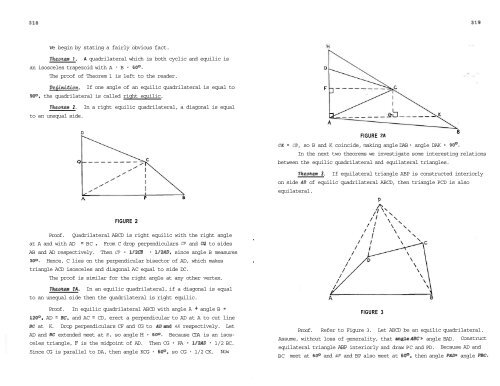Vol. 7 No 5 - Pi Mu Epsilon
Vol. 7 No 5 - Pi Mu Epsilon
Vol. 7 No 5 - Pi Mu Epsilon
Create successful ePaper yourself
Turn your PDF publications into a flip-book with our unique Google optimized e-Paper software.
We begin by stating a fairly obvious fact.<br />
Theoklim 1.<br />
A quadrilateral which is both cyclic and equilic is<br />
an isosceles trapezoid with A = B = 60°<br />
The proof of Theorem 1 is left to the reader.<br />
Ve&kni^ion. If one angle of an equilic quadrilateral is equal to<br />
90° the quadrilateral is called right equilic.<br />
Th~oklim 2. In a right equilic quadrilateral, a diagonal is equal<br />
to an unequal side.<br />
FIGURE 2A<br />
8<br />
CK = CB, so B and K coincide, making angle DAB = angle DAK = 90'.<br />
In the next two theorems we investigate some interesting relations<br />
between the equilic quadrilateral and equilateral triangles.<br />
Tfteo~em 3. If equilateral triangle ABP is constructed interiorly<br />
on side A5 of equilic quadrilateral ABCD, then triangle PCD is also<br />
equilateral.<br />
FIGURE 2<br />
Proof. Quadrilateral ABCD is right equilic with the right angle<br />
at A and with AD = BC . From C drop perpendiculars CP and CQ to sides<br />
AB and AD respectively. Then CP = 1/2CB = 1/2AD, since angle B measures<br />
f<br />
30° Hence, C lies on the perpendicular bisector of AD, which makes Ã<br />
triangle ACD isosceles and diagonal AC equal to side DC.<br />
The proof is similar for the right angle at any other vertex.<br />
Thokern 2A. In an equilic quadrilateral, if a diagonal is equal<br />
to an unequal side then the quadrilateral is right equilic.<br />
Proof. In equilic quadrilateral ABCD with angle A + angle B =<br />
120° AD = BC, and AC = CD, erect a perpendicular to AD at A to cut line<br />
BC at K. Drop perpendiculars CF and CG to ADand AK respectively. Let<br />
AD and BC extended meet at H, so angle H = 600. Because CDA is an isosceles<br />
triangle, F is the midpoint of AD. Then CG = FA = 1/2AD = 1/2 BC.<br />
Since CG is parallel to DA, then angle KCG = 60° so CG = 1/2 CK. <strong>No</strong>w<br />
FIGURE 3<br />
Proof. Refer to Figure 3. Let ABCD be an equilic quadrilateral.<br />
Assume, without loss of generality, that angleABC> angle BAD. Construct<br />
equilateral triangle ABP interiorly and draw PC and PD. Because AD and<br />
BC meet at 60 and AP and BP also meet at 60° then angle PAD= angle PBC.
















